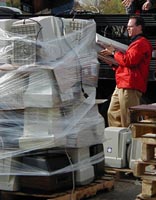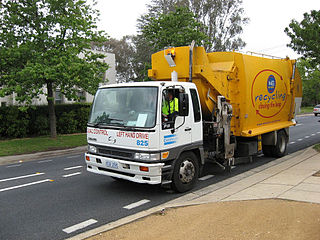
Recycling is the process of converting waste materials into new materials and objects. This concept often includes the recovery of energy from waste materials. The recyclability of a material depends on its ability to reacquire the properties it had in its original state. It is an alternative to "conventional" waste disposal that can save material and help lower greenhouse gas emissions. It can also prevent the waste of potentially useful materials and reduce the consumption of fresh raw materials, reducing energy use, air pollution and water pollution.

A home appliance, also referred to as a domestic appliance, an electric appliance or a household appliance, is a machine which assists in household functions such as cooking, cleaning and food preservation.

The Waste Electrical and Electronic Equipment Directive is a European Community Directive, numbered 2012/19/EU, concerned with waste electrical and electronic equipment (WEEE). Together with the RoHS Directive 2011/65/EU, it became European Law in February 2003. The WEEE Directive set collection, recycling and recovery targets for all types of electrical goods, with a minimum rate of 4 kilograms (9 lb) per head of population per annum recovered for recycling by 2009. The RoHS Directive set restrictions upon European manufacturers as to the material content of new electronic equipment placed on the market.

The Restriction of Hazardous Substances Directive 2002/95/EC, short for Directive on the restriction of the use of certain hazardous substances in electrical and electronic equipment, was adopted in February 2003 by the European Union.

Electronic waste recycling, electronics recycling, or e-waste recycling is the disassembly and separation of components and raw materials of waste electronics; when referring to specific types of e-waste, the terms like computer recycling or mobile phone recycling may be used. Like other waste streams, reuse, donation, and repair are common sustainable ways to dispose of IT waste.

Electronic waste describes discarded electrical or electronic devices. It is also commonly known as waste electrical and electronic equipment (WEEE) or end-of-life (EOL) electronics. Used electronics which are destined for refurbishment, reuse, resale, salvage recycling through material recovery, or disposal are also considered e-waste. Informal processing of e-waste in developing countries can lead to adverse human health effects and environmental pollution. The growing consumption of electronic goods due to the Digital Revolution and innovations in science and technology, such as bitcoin, has led to a global e-waste problem and hazard. The rapid exponential increase of e-waste is due to frequent new model releases and unnecessary purchases of electrical and electronic equipment (EEE), short innovation cycles and low recycling rates, and a drop in the average life span of computers.
Urban mining is the recovery of building materials from buildings. This means that materials can be removed from a building in various stages from the point it is deemed that the building is to be removed at end-of-life, or renovated, retrofitted, or remodeled. Without affecting the major structure, equipment, fixtures, furnishings, finishes, and even non-structural components, like windows, doors, and divider walls, can be removed, when permitted, for their value in reuse or recycling or upcycling as raw materials into new products.
There is no national law in the United States that mandates recycling. State and local governments often introduce their own recycling requirements. In 2014, the recycling/composting rate for municipal solid waste in the U.S. was 34.6%. A number of U.S. states, including California, Connecticut, Delaware, Hawaii, Iowa, Maine, Massachusetts, Michigan, New York, Oregon, and Vermont have passed laws that establish deposits or refund values on beverage containers while other jurisdictions rely on recycling goals or landfill bans of recyclable materials.

In 2015, 43.5% of the United Kingdom's municipal waste was recycled, composted or broken down by anaerobic digestion. The majority of recycling undertaken in the United Kingdom is done by statutory authorities, although commercial and industrial waste is chiefly processed by private companies. Local Authorities are responsible for the collection of municipal waste and operate contracts which are usually kerbside collection schemes. The Household Waste Recycling Act 2003 required local authorities in England to provide every household with a separate collection of at least two types of recyclable materials by 2010. Recycling policy is devolved to the administrations of Scotland, Northern Ireland and Wales who set their own targets, but all statistics are reported to Eurostat.

Vehicle recycling or automobile scrapping is the dismantling of vehicles for spare parts. At the end of their useful life, vehicles have value as a source of spare parts and this has created a vehicle dismantling industry. The industry has various names for its business outlets including wrecking yard, auto dismantling yard, car spare parts supplier, and recently, auto or vehicle recycling. Vehicle recycling has always occurred to some degree but in recent years manufacturers have become involved in the process. A car crusher is often used to reduce the size of scrapped vehicles for simplified transportation to a steel mill.
The End of Life Vehicles Directive is a Directive of the European Union addressing the end of life for automotive products. Every year, motor vehicles which have reached the end of their useful lives create between 8 and 9 million tonnes of waste in the European Union. In 1997, the European Commission adopted a Proposal for a Directive to tackle this problem.

Recycling in Japan, an aspect of waste management in Japan, is based on the Japanese Container and Packaging Recycling Law. Plastic, paper, PET bottles, aluminium and glass are collected and recycled. Japan's country profile in Waste Atlas shows that in 2012 Recycling Rate was 20.8%.

Electronic waste or e-waste in the United States refers to electronic products that have reached the end of their operable lives, and the United States is beginning to address its waste problems with regulations at a state and federal level. Used electronics are the quickest-growing source of waste and can have serious health impacts. The United States is the world leader in producing the most e-waste, followed closely by China; both countries domestically recycle and export e-waste. Only recently has the United States begun to make an effort to start regulating where e-waste goes and how it is disposed of. There is also an economic factor that has an effect on where and how e-waste is disposed of. Electronics are the primary users of precious and special metals, retrieving those metals from electronics can be viewed as important as raw metals may become more scarce

Electronic waste is a significant part of today's global, post-consumer waste stream. Efforts are being made to recycle and reduce this waste.
Products made from a variety of materials can be recycled using a number of processes.
Electronic waste in Japan is a major environmental issue. Although Japan was one of the first countries to implement an electronic waste recycling program, it is still having serious issues. In this day and age, e-waste disposal has become of major importance due to the increasing demand for electronics on a worldwide scale. In 2013, the Japanese government reported that roughly 550 thousand tonnes of e-waste was collected and treated in Japan, which only equates to about 24-30% of total e-waste. Not only does e-waste harm the environment if untreated, it also becomes a fiscal loss due to the material lost that could have been salvaged.
Electronic waste or e-waste in China refers to electronic products that are no longer usable and are therefore dumped or recycled. China is the world's largest importer and producer of electronic waste with over 70% of all global e-waste ending up in the world's largest dumpsites. An estimated 60–80% of this e-waste is handled through illegal informal recycling processes, without the necessary safety precautions legally required by Chinese government regulations. Processing e-waste in this way directly causes serious environmental damage and permanent health risks in areas surrounding the disposal sites. While the Chinese government and the international community have taken action to regulate e-waste management, ineffective enforcement, legislative loopholes, and the pervasiveness of informal recycling have been obstacles to mitigating the consequences of e-waste.

MBA Polymers is a recycling company with operations globally that recovers plastics from waste electrical and electronic equipment (WEEE) and auto-shredder residue from end-of-life automobiles (ELV).

Recycling in Australia is a widespread, and comprehensive part of waste management in Australia, with 60% of all waste collected being recycled. Recycling is collected from households, commercial businesses, industries and construction. Despite its prominence, household recycling makes up only a small part (13%) of Australia's total recycling. It generally occurs through kerbside recycling collections such as the commingled recycling bin and food/garden organics recycling bin, drop-off and take-back programs, and various other schemes. Collection and management of household recycling typically falls to local councils, with private contractors collecting commercial, industrial and construction recycling. In addition to local council regulations, legislation and overarching policies are implemented and managed by the state and federal governments.
The guideline committee VDI 2343 "Recycling of electrical and electronic devices" was initiated in 1996 by Ralf Brüning. The aim is to develop practical and legally compliant recommendations for action in order to support the affected groups in their work, for expample disposal companies, manufacturers, universities, authorities, lawyers, environmental associations, reuse companies. Thereby among other things the aspects of logistics, dismantling, processing, recycling and reuse are dealt with in seven sub-committees and coordinated in an overall committee.














